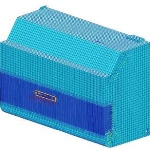ABS And HHI Evaluate Arctic LNG Carrier Designs
 The industry has accumulated plenty of operating experience for LNG carriers, however, experience of large LNG carriers operating in Arctic waters is very limited. ABS has been collaborating with Korea’s Hyundai Heavy Industries (HHI) to evaluate the basic design and containment system parameters for an LNG carrier, specifically operating a trade route from the Kara Sea and Barents Sea to Europe or the United States.
The industry has accumulated plenty of operating experience for LNG carriers, however, experience of large LNG carriers operating in Arctic waters is very limited. ABS has been collaborating with Korea’s Hyundai Heavy Industries (HHI) to evaluate the basic design and containment system parameters for an LNG carrier, specifically operating a trade route from the Kara Sea and Barents Sea to Europe or the United States.
There are many technical concerns related to the structural strength of LNG carriers subject to intensive ice loads. These include strengthening of the hull, the interaction of the hull structure with the containment system, minimum propulsion power requirements and strength of the propeller. To address these issues, ship and ice interaction scenarios have been investigated primarily using Finite Element (FE) analysis tools. Based on FE results and assessment criteria, the effects to the cargo containment systems in LNG carriers can be evaluated.
Harsh Environment
ABS has combined its LNG classification experience with the knowledge gained through its Harsh Environment Programme to provide industry with guidance on these vessels to be operated in ice-covered waters. ABS has developed specific analysis procedures for assessing the interaction between ice and the hull structure under different operational scenarios. This is a key element in evaluating the performance of LNG carriers under ice loads.
HAZID
For the HHI evaluation, ABS is undertaking a hazard identification (HAZID) study to identify potential hazards and risks associated with the potential effects of ice navigation as well as providing an assessment of the Gaztransport & Technigaz Mark III membrane containment system (GTT Mark III) in an ice operations scenario. According to ABS Technology & Business Development Director Hoseong Lee and the lead investigator for the evaluation, the HAZID study is divided into three main categories: design issues, natural and regulatory environments and operational scenarios.
Categories
In terms of design, the evaluation will take into consideration the mode of operation, hull form, ice loads on hull and vibration.From a natural and regulatory perspective, the evaluation will review Russian requirements as well as met-ocean and ice data from the region. Lastly, in terms of operational scenarios transit in ice-covered waters will be examined, which includes such conditions as high and low speed transit, low speed backward in ice, and high speed transit in iceberg infested areas as well as operation near receiving terminals which take into account manoeuvring, berthing and emergency operations with assistance.






